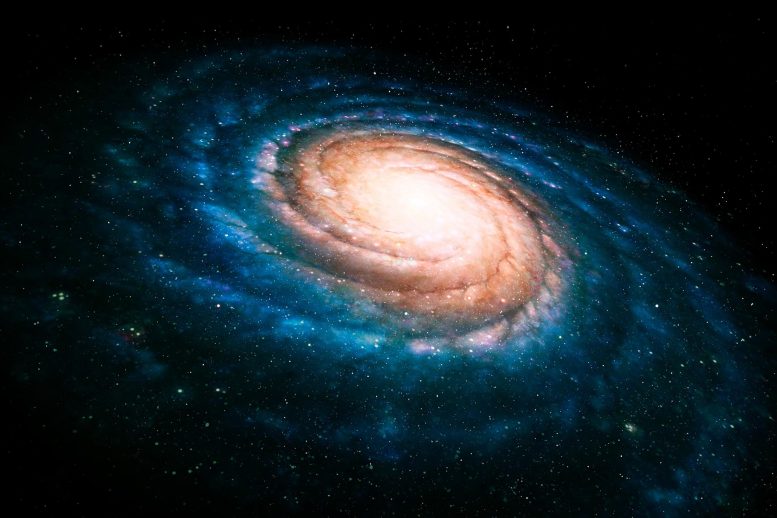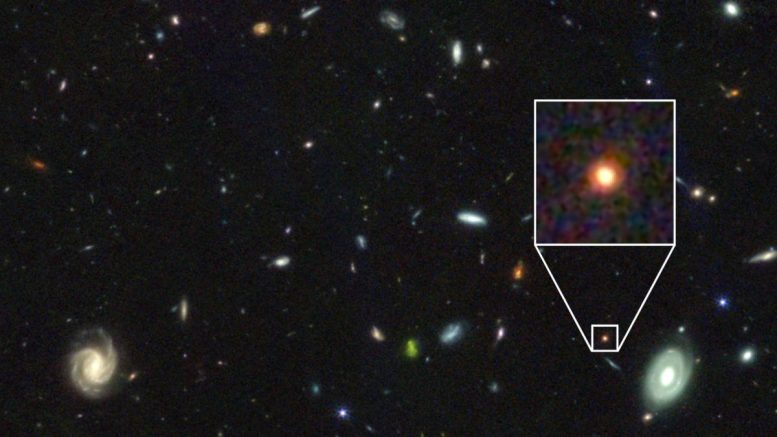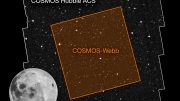
GS-9209, a galaxy discovered by Edinburgh researchers and detailed by the James Webb Space Telescope, is the earliest known quiescent galaxy, forming 600 to 800 million years after the Big Bang and ceasing star production half a billion years later. Despite being smaller than the Milky Way, it contains a similar number of stars and a central supermassive black hole five times larger than anticipated, which may have halted star formation by emitting high-energy radiation that drove out galactic gas.
Utilizing the most powerful telescope to date, astronomers have identified a colossal and tightly clustered galaxy situated 25 billion light-years away.
GS-9209, a galaxy that emerged just 600 to 800 million years following the Big Bang, has been identified as the earliest galaxy of its type ever discovered, according to scientists.
Detailed properties of GS-9209 were revealed for the first time through the use of the James Webb Space Telescope, under the direction of a team of researchers from Edinburgh.
Star-studded galaxy
Despite being around 10 times smaller than the Milky Way, GS-9209 has a similar number of stars to our own galaxy.
These have a combined mass around 40 billion times that of our Sun, and were formed rapidly before star formation in GS-9209 stopped, the team says.
GS-9209 is the earliest known example of a galaxy no longer forming stars – known as a quiescent galaxy. When the team observed it at 1.25 billion years after the Big Bang, no stars had formed in the galaxy for about half a billion years.

GS-9209 observed by the James Webb Space Telescope next to other galaxies. Credit: G. Brammer, C. Williams, A. Carnall
Vast distance
The galaxy is 25 billion light years away today, researchers say, but when the light started traveling from it to us about 12.5 billion years ago, it was much closer, because the Universe is expanding.
This means, despite the Universe being an estimated 13.8 billion years old, it is possible to see things as far away as around 45 billion light-years, they add.
Shutdown theory
The analysis also shows that GS-9209 contains a supermassive black hole at its center that is five times larger than astronomers might anticipate in a galaxy with this number of stars. The discovery could explain why GS-9209 stopped forming new stars, the team says.
The growth of supermassive black holes releases huge amounts of high-energy radiation, which can heat up and push gas out of galaxies. This could have caused star formation in GS-9209 to stop, as stars form when clouds of dust and gas particles inside galaxies collapse under their own weight.
Dr. Adam Carnall states, “The James Webb Space Telescope has already demonstrated that galaxies were growing larger and earlier than we ever suspected during the first billion years of cosmic history. This work gives us our first really detailed look at the properties of these early galaxies, charting in detail the history of GS-9209, which managed to form as many stars as our own Milky Way in just 800 million years after the Big Bang.”
He continues, “The fact that we also see a very massive black hole in this galaxy was a big surprise, and lends a lot of weight to the idea that these black holes are what shut down star formation in early galaxies.”
Galaxy discovery
GS-9209 was first discovered in 2004 by Edinburgh Ph.D. student Karina Caputi, who was supervised at the time by Professors Jim Dunlop and Ross McLure in the University’s School of Physics and Astronomy. Caputi is now a Professor at the University of Groningen, Netherlands.
Reference: “A massive quiescent galaxy at redshift 4.658” by Adam C. Carnall, Ross J. McLure, James S. Dunlop, Derek J. McLeod, Vivienne Wild, Fergus Cullen, Dan Magee, Ryan Begley, Andrea Cimatti, Callum T. Donnan, Massissilia L. Hamadouche, Sophie M. Jewell and Sam Walker, 22 May 2023, Nature.
DOI: 10.1038/s41586-023-06158-6
The study was funded by the Leverhulme Trust, Science and Technology Facilities Council, and UK Research and Innovation.









There is no such thing called spacetime in nature, not to mention the expansion of spacetime. The concept of spacetime is from Einstein’s relativity which has already been disproved.
We know that a variable can only be defined once. Any double definition of a variable will either generate contradictions or become redundant. Time had been defined by physical clocks which is equivalent to Galilean absolute time, but Einstein used Lorentz Transformation to have redefined the space and time:
t = T/γ – (γv/c^2)X
x = γX
y = Y
z = Z
γ = 1/sqrt(1 – v^2/c^2)
where (T, X, Y, Z) are Galilean time and space coordinates, v is the velocity of local aether, c is the isotropic speed of light, (t, x, y, z) are the relativistic time and relativistic space coordinates. You can easily verify that this definition of time and space follows Lorentz Transformation.
According to Lorentz Transformation, the time of the moving frame t’ is shorter than the time of the stationary frame t:
t’ = t/γ < t
which is so called "time dilation", from which mainstream physicists including Einstein jump to a conclusion that the frequency of the moving clock becomes lower than that of the stationary clock. They even believe that the traveling twin would be younger than the twin stayed on the earth when they reunited on the earth after a space travel.
But the period of the moving clock p' as an interval of the time of the moving frame should also be shorter than the period of the stationary clock p:
p' = p/γ 1/p > f
That means, the effect of “time dilation” will make the moving clock tick faster than the stationary clock, a fatal contradiction to the claim of special relativity that the moving clock ticks more slowly than the stationary clock. This contradiction disproves special relativity.
People claim that there are numerous experiments that have proved special relativistic effects, but we can use special relativity itself to prove that all relativistic effects can never be shown on any physical process in the universe because in real experiments, all we can observe is the change of a physical process and the change is always the product of time and the changing rate, as the time of the moving frame becomes shorter than that of the stationary frame, the changing rate on the moving frame, just like the frequency of the moving clock, becomes faster than that on the stationary frame to make the change i.e. the product of time and the changing rate the same as that of the stationary frame, i.e., the relativistic effects of the time and the changing rate always cancel each other in the product to make the change of the process Lorentz invariant. Therefore, we can never see relativistic effects in any experiments, and all so-called experimental proofs are misinterpretations of other effects such as the effects of aether – the medium of light, the existence of which is a direct conclusion of the disproof of special relativity.
The absoluteness of the physical time measured with physical clocks can also be seen in the following reasoning:
Let a series of vertically standing candles as clocks with the same initial height and burning rate move at different constant horizontal velocities relative to an inertial reference frame of (x, y, z, t) where x, y, z, t are relativistic space coordinates and relativistic time. Thus, at any moment t of the relativistic time of the reference frame (x, y, z, t), all candles have the same height H relative to the reference frame of (x, y, z, t) and the height H represents the physical time of the clocks. Therefore, we have the simultaneous events in both relativistic time t and physical time H relative to the frame of (x, y, z, t):
(Candle1, x1, y1, H, t), (candle2, x2, y2, H, t), …, (CandleN, xN, yN, H, t)
When these events are observed on anther horizontally moving inertial reference frame (x’, y’, z’, t’), according to special relativity, these events in the reference frame of (x’, y’, z’, t’) can be obtained through Lorentz Transformation:
(Candle1, x’1, y’1, H, t’1), (Candle2, x’2, y’2, H, t’2), … , (CandleN, x’N, y’N, H, t’N),
where t’1, t’2, …, and t’N are relativistic times of the events in the frame of (x’, y’, z’, t’). It is seen that after Lorentz Transformation, these events have different relativistic times:
t’1 ≠ t’2 ≠ … ≠ t’N
That is they are no longer simultaneous in terms of the relativistic time of the frame of (x’, y’, z’, t’). But the heights of the candles remain the same H because the vertical heights here do not experience any Lorentz contraction. As the heights of the candles represent the physical time, these events still have the same physical time, i.e., they are still simultaneous in terms of the physical time H. Therefore, the physical time is Lorentz invariant, absolute and independent of inertial reference frames, which is different from relativistic time. Thus relativistic time is no longer the physical time measured with physical clocks, but an artificial time without physical meaning.
Some people may argue that atomic clocks won’t behave like that. Please note that all clocks including atomic clocks can always use the height of a stick to represent their accurate time which will behave exactly the same as the candle clock.
That Galaxy @ 25 Billion Light years away… It isn’t there anymore. Conflict of TIME/SPACE/LOGIC? Invent a new Rule of Thumb: Yep! The Universe is EXPANDING. BUT… That distant Galaxy is somehow FIXED in Space and Time… Quite the CONUNDRUM. And inherently NEARSIGHTED.
To Wit: MAYBE… That max distant limit of 45 BILLION Light Years is merely the limit of your vision, Mr. Magoo (Googlie him).
What’s the next CONUNDRUM: How many angels can fit on the head of a Pin?
Science smacking of Religion: Men and Women “of The Cloth”, without the Cloth or the god; merely the avocation. Like asking for a Cosmic Beat-down.
Which Is To Say ( the nefarious WITS): The Maths are MODELING TOOLS.
As to MODELS and pass-times: I built a 1/32 Scale A-1H Skyraider. Extremely detailed; right down to a CD deck (with disc) in the cockpit, among other challenging details. Alas, despite the complexity, it will NEVER fly.
Science and its Deus Ex Machina (god out of a machine) is like THEATER; but more like an INFINITE Mass for the misbegotten.
✋
HOSANNA!
“The galaxy is 25 billion light years away today, researchers say, but when the light started traveling from it to us about 12.5 billion years ago, it was much closer, because the Universe is expanding.”
“This means, despite the Universe being an estimated 13.8 billion years old, it is possible to see things as far away as around 45 billion light-years, they add.”
This is classic “science outreach,” I mean “science Outreach” is apparently code for formally turning educated guesses into absolute assertions made with absolute sureness because gaining attention is presumed impossible otherwise (a low self-esteem or low social esteem issue, in other words). “Science outreach” is apparently code for writing as if communicating to an audience of children with no demonstrated interest in “The Big Bang.” “Science outreach” is apparently code for exploiting ideas having no practical application. “Science outreach” apparently inevitably leads to a pointless discussion about “black holes eating.” “Science outreach” is likely attempting to pass itself off as “religion deprogramming” except it appears to be essentially about something completely different and just as misguided.
Long story short, there are several reasons to suspect gravity eventually gains immense effectiveness as matter cools, enough to support an oscillating universe condition. I’ve discussed many details of a plausible cold focus mechanism in quark triplet gravity elsewhere on this site. In such an oscillatory condition, details of universe creation eventually become irrelevant although indications of a hotter and less expanded state in the past are inevitable, and such indications are unlikely to offer clues on the number of intervening cyclic iterations.
They should employ the James Webb telescope to look non-stop for one month towards the emptiest place we know with it’s most sensitive infrared sensor turned on. Let’s see the condition of the oldest thing it can capture. This might have helped solve many controversies.
I’m hardly as intelligent as the rest of you, but I am glad to know that finally common sense prevails, and that so many of the theories on the nature of reality attributed to ALBERT EINSTEIN are at last being exposed as nothing more than overly rated Hocus Pocus. Amen…Praise…😀…the LORD.
“Researchers Reveal Traits of Ancient Galaxy 25 Billion Light-Years Away”
The light image we are seeing is from ~13.8 billion years ago. Stop creating clickbait titles like 25 billion or 45 billion lightyears distant.
My understanding has always been that…YEARS…as a title, is a measurement of TIME……And that LIGHTYEARS as a title is a measurement of DISTANCE…as distinct as APPLES are from ORANGES……Correct me if I am mistaken if you please…..to wit…a ROSE is a ROSE is a ROSE by any other name……Have a nice day.
Seriously? Ever drive a car? It has MILESPERHOUR on the speedometer (or KILOMETERSPERHOUR) If a car traveled at 100 miles per hour all the time, without stopping, slowing down or speeding up, then the DISTANCE between NY and LA would be CARHOURS. 30 HOUR x 100 MILES/HOUR = 3000 MILES. Simple.